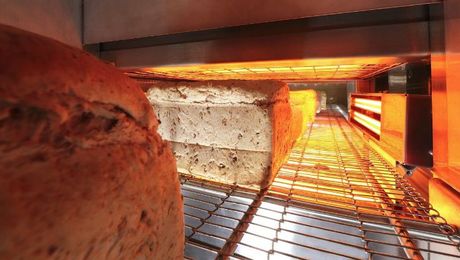Infrared surface disinfection for both the bakery and the bread

Infrared radiation can transfer large amounts of energy in a very short time. This combination of features means that bakeries can use the radiation to disinfect both bakery equipment and bread. Shelf-life increases of three or four days have been reported after bread has been subjected to carbon medium wave infrared (IR) radiation for four seconds prior to wrapping.
Infrared is already widely used within the food sector, providing targeted, controllable heat. Typical applications range from browning ready meals to improving and maintaining chocolate quality and reducing the fat content of many fried products by surface sealing.
The technology can also be used for thermal disinfection, reducing the mould, fungi and bacterial load on equipment and products. The penetrating action of the carbon emitters means that thick spore layers, porous surfaces and dust particles do not limit the germ-reducing effect.
Heraeus Noblelight infrared emitters with Carbon Infrared Technology (CIR) offer power densities up to 150 kW/m² and response time of the order of seconds. These fast response times allow for very good controllability so that heat is applied for only as long as necessary, drying and disinfection cycles can be programmed and, if there is inadvertent stoppage of the conveyor belt, overheating of the baked goods or the machinery itself is prevented.
Disinfect the bakery equipment
Studies show that, with carbon infrared emitters, there is sufficient germ reduction of baking trays between 130 and 140°C in less than 30 seconds. The spore reduction is achieved between 120 and 160°C within 10 to 30 seconds, depending on the emitter power, the wetness of the tray and the desired speed of operation. In the bakery sector, Heraeus Carbon Infrared is already allowing simple, quick and safe disinfection of baking trays, conveyors and other bakery equipment, killing germs and spores to eliminate mildew and fungal growth.
Because of the compact construction of an infrared emitter system, it is possible to retrofit infrared disinfection into existing plant. Moreover, muslin tray cloths are also dried by infrared. This is important when a bakery plant is operated round the clock and it is not possible to carry out drying in the idle phases. By carrying out this infrared drying in parallel with the disinfection, the operating life of the muslin cloths is significantly extended, allowing greater intervals between replacements.
For certain applications, infrared is much more practical than ultraviolet disinfection, which is effective mainly on smooth surfaces and requires a high UV dose to destroy mould and fungi. Carbon infrared emitters from Heraeus are also eminently controllable, with a response time of 1–2 seconds, so that there is no danger of overheating baked items in the event of unplanned conveyor stoppage. They are also extremely compact, allowing easy retrofitting into existing machinery, and emitter fields can be adjusted to match the width of baking trays.
Disinfect the bread
Mould contamination of the bread surface between baking and packing is a well-known problem in large-scale bakeries. Mould spores are naturally present within a bakery environment and contamination can take place as the bread cools before it is wrapped.
Heraeus Noblelight CIR heating systems have been shown to reduce the formation of mould on baked bread, prior to packing, significantly extending bread shelf life. Typically, shelf life has been increased by three to four days on breads subjected to carbon medium wave infrared radiation for four seconds.
Heraeus has carried out successful tests, both in its global applications centres and on-site at various bakeries, to demonstrate the effectiveness of infrared as a mould-prevention technology. It has been shown that mould contamination is prevented if the bread is heated for a few seconds before final packing. Because of the short exposure time, there is no detrimental effect on the taste or texture of the bread.
Australian bushfood could extend shelf life of meat
Kakadu plum is showing promise as a chemical-free alternative for meat preservation due to its...
Specialised compressed air for the food industry
Compressed air is a key utility supporting the food packaging and food processing industries in...
Mars steams ahead with renewable technology for pet food process
Mars Petcare's home-grown sustainability venture Green Steam allows its Wodonga factory to...












